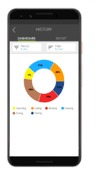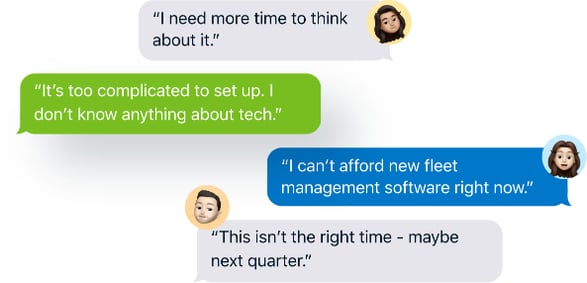
The Ultimate Guide to Fleet Management
- 1 - What is Fleet Management and who Needs it?
- 2 - 5 reasons why you need fleet management
- 3 - What every new fleet manager should know
- 1 - What is fleet monitoring and how does it work?
- 2 - Expert tips on how to reduce fleet costs
- 3 - What you need to know about setting up mobile resource management
- 4 - How to increase productivity with optimized fleet scheduling
- 5 - How to save time and money with better route management
- 6 - Why you should digitize document management
- 7 - Best practices for fleet sustainability in 2021
- 8 - 9 Essential Fleet Management Tools for 2021
What is Fleet Management and who Needs it?
What do construction vans, heavy machinery and 18-wheeler semi trucks have in common? They are all examples of fleet vehicles. Any vehicle used by a company for work (whether it’s for transporting people or goods) counts as a fleet vehicle.
Businesses of all sizes own fleets: from mom and pop operations to global enterprises. Industries that rely on fleets include:
Construction
Utilities
Food Delivery
Tool Rental
Painting
Cleaning & Sanitation
IT
Manufacturing
Retail & Wholesale
Keeping track of all these commercial vehicles requires fleet management. Fleet management helps businesses increase productivity and revenue while decreasing operational expenses. This keeps companies profitable, especially during today’s ever-changing economic climate.
Did you know? 79% of fleets that use GPS fleet management software consider it important to running efficient operations. (Driscoll, 2018)
5 reasons why you need fleet management
Fleet managers are responsible for ensuring smooth fleet operations on a daily basis. Every day, they must make critical decisions that impact a business's profitability. To make these decisions, managers often use fleet management software. Software like Logifleet helps them do their jobs better and faster. Who wouldn’t want that?
Proper fleet management boasts a variety of benefits, including:
- Reduced cost for fuel, repairs, maintenance, loss prevention, staff wages and overhead
Increased fleet productivity and company growth - Greater transparency and clearer policies to increase employee accountability
- Better safety and security for drivers, vehicles and cargo
- Faster delivery and service, which increases customer satisfaction
Logifleet helps customers achieve exceptional results. Here are some recent examples:
Enzler
Cleaning & Sanitation
12,000 CHF
Saved 12,000 CHF in fuel costs after just one year
*with an 11-vehicle fleet
Nexans
Cable & Fiber Manufacturing
2 Months
Reduced billing deadlines by 2 months
Axians Suisse
ICT Service provider
25%
Reduced fleet mileage by 25% by optimizing vehicle use
Electro-Contact
Electrical
100%
Reduced overtime by 100%
What every new fleet manager should know
A fleet manager is a logistics specialist who works in the transportation industry. They may have a degree in business administration, logistics or accounting. Great fleet managers often have exceptional analytical, problem-solving, interpersonal and communication skills.
Here is an overview of a typical fleet manager’s responsibilities. (Hint: Logifleet helps with all these tasks!) Great fleet managers should be experts in all the following areas.
-
Vehicle Acquisition & Maintenance
Fleet managers are responsible for forecasting a fleet’s transportation needs. They also buy or lease the necessary vehicles. This ensures the fleet is always ready to meet its business needs. Post-purchase, fleet managers are also in charge of tracking vehicle-related billing and expenses. Finally, they need to know enough about mechanics to authorize and evaluate ongoing repairs and maintenance.
-
Transportation Logistics
Fleet managers create driver schedules, vehicle assignments and optimize routes. Their job is to ensure high levels of staff productivity and customer satisfaction. Fleet management software like Logifleet helps them make better, data-driven business decisions, faster. In Driscoll’s 2018 study, 64% of fleets currently, or at one time, use GPS fleet management systems. Learn More
-
Lowering Operational Costs
One of the biggest expenses in fleet management is fuel. Fleet managers must reduce fuel and operational costs as much as possible. They manage department budgets by looking at balance sheets and creating expense strategies.
-
Legal Compliance
It’s a lot of work, but someone has to do it. Fleet managers set up, maintain and organize vehicle licensing, registration and insurance records. They are responsible for keeping their fleet legally compliant. Fleet managers need to stay up-to-date on the latest national and local transport laws, regulations and rules.
-
Fleet Monitoring
Keeping track of three or four vehicles is already difficult. But as a company scales and its fleet grows, overseeing dozens or even hundreds of vehicles can be a herculean task. That’s why fleet managers rely on GPS telematics. Fleet monitoring software shows an overview of all mobile assets. Managers can see both “the big picture” and details about each vehicle (and driver) at any given time. This level of visibility ensures smooth, successful operations. It also keeps drivers safer on the road and reduces theft and inventory loss.
-
Driver Safety, Recruitment, Training and Retention
It can be difficult to keep drivers safe and accountable, especially if they’re far away. Fleet managers have the important responsibility of remotely ensuring safe driving behavior. This can be a real challenge! That’s why most fleet managers need excellent communication and interpersonal skills. Modern-day software like Logifleet allows fleet managers to better supervise and train their staff. Real-time and historical data also helps managers when it comes to performance reviews. Data-driven feedback fosters better workplace communications and employee satisfaction. It also increases transparency and accountability, too. Happier drivers are also more likely to stay loyal to their company!

How to Reduce Fleet Costs and Increase Productivity
What is fleet monitoring and how does it work?
Fleet monitoring software collects and analyzes data on mobile assets in real time. This data comes from battery-operated GPS units. Place Logifleet GPS units on fleet vehicles, heavy equipment and even hand-operated tools. Simple “plug-and-play” installation gives companies instant visibility into its most vital assets. Fleet managers can review this data at their convenience via the web or mobile app. This handy and powerful tool is both accessible and convenient.
Fleet monitoring systems provide essential data to help fleet managers do their jobs. This includes:
- Real-time vehicle locations pinpointed on a street or satellite map
- Route information (trip route, duration, distance traveled, geozones, traffic and detours)
- Vehicle health metrics (fuel consumption, sensor alerts, maintenance reminders)
- Driver behavior (driving speed, braking and acceleration, idle time)
Learn more pro fleet monitoring tips (and best practices) here.
Fleet monitoring ensures drivers are staying safe and accountable during working hours. By analyzing real-time and historical data, managers can better evaluate staff performance. Fleet monitoring also helps managers make better decisions. Decisions that increase staff productivity, decrease operational costs and improve customer satisfaction!
Expert tips on how to reduce fleet costs
Fleet inventory alone could cost hundreds of thousands, sometimes even millions of euros. Other fleet costs include: driver salaries, emergency repairs, regular vehicle maintenance, insurance and fuel.
Fleet managers need to reduce inefficiencies to improve the organization’s bottom line. Their job and the organization’s future success depends on it. Modern fleet management software like Logifleet helps fleet managers work smarter, not harder.
Focus on these three main areas to make the biggest impact when it comes to reducing fleet costs:
-
Managing a vehicle’s cost of ownership.
Managing a vehicle’s total cost of ownership involves taking a look at both the fixed and variable costs.
Staying on top of maintenance and repairs helps vehicles last longer. It’s always better to discover problems early and fix them before they turn into costly repairs. Regular maintenance can also reduce vehicle downtime and save on fuel costs.
But, fleet managers also need to assess the pros and cons of keeping old vehicles (instead of buying new ones). Sometimes, retaining and maintaining an old vehicle doesn’t make business sense. Older vehicles may be more prone to breakdowns. This results in delays, reduced productivity and extra repair costs. They also won’t be as fuel-efficient as newer models. Good fleet managers take these factors into consideration during budget reviews.
-
Managing driver behavior
Aggressive driving, excessive idling and inconsistent driving speeds increase fuel costs. That’s why fleet managers should focus on recruiting, training and retaining excellent drivers. Safe, qualified drivers, trained on best practices, can reduce fuel costs by up to 15-40%!
-
Reduce, reduce, reduce
It’s hard to save time and money. Fleet management software helps managers make the right decisions at the right time. These decisions often make huge impacts on a company’s bottom line.
It’s a no-brainer that most businesses could cut costs somewhere and make more profit. But where?
Here are some tips to reduce fleet costs:
- Reduce fleet size
Regularly assess and forecast business needs. Trim the fleet by selling unnecessary or underperforming vehicles. Avoid buying or renting unnecessary vehicles with the help of fleet monitoring tools. - Reduce driving speed
Reduce driving speeds to keep the roads safer and the air cleaner, too. Follow the speed limit and use cruise control to increase gas mileage and lower fuel costs. - Reduce vehicle/equipment/cargo damage and theft
Cargo theft, vehicle hijacking and equipment abuse cost business owners billions of dollars per year. Fleet monitoring increases security and helps mitigate some of these risks. - Reduce unnecessary or redundant trips
Fleet management software helps fleet managers plan smarter routes. It does this using algorithms and real-time contextual data. Smart planning reduces unnecessary detours and extra miles.
- Reduce fleet size
What you need to know about setting up mobile resource management
Vehicle and cargo theft. Misplaced or lost equipment. Underused or overused machines. These are some of the major problems fleet managers can prevent by implementing mobile resource management.
Mobile resource management (or MRM) involves setting up hardware to monitor mobile assets, heavy machinery and other equipment. This hardware transmits data to connected software. (Learn more here.)
For the trucking industry, this means tracking large commercial vehicles. Other industries, such as construction, use MRM to monitor assets such as excavators, generators or forklifts.
With Logifleet, managers can review all asset data and reports on one convenient platform. Companies can control and access their own data at any time without relying on third-party hardware. The data is alway safe and protected, with 99.9% uptime. Rest assured, this private data is never shared with vehicle and equipment manufacturers!
Logifleet’s plug-and-play GPS units are simple and easy to install and use. Other units need drivers to manually connect to the software before every trip. Our autonomous, hassle-free products only need to be set up once. We also offer exceptional customer support. Our clients get on-site support for installation, training, or configuring technical issues.
Overview of LogiFleet Products
 Small GPS Device with batteries - no wires needed
Small GPS Device with batteries - no wires needed
 Staff use a mobile app to track their trips and hours. Managers review this data via a mobile or web app.
Staff use a mobile app to track their trips and hours. Managers review this data via a mobile or web app.
Interested in trying Logifleet? Contact us today for a free demo.
How to increase productivity with optimized fleet scheduling
Tired of miscommunications (or even lack of communications) between fleet managers and their teams?
Worried about inaccurate trip estimations and delays impacting brand reputation?
Overwhelmed by personnel files, driver timesheets and work schedules?
Better fleet management software is the solution to most fleet management problems.
The key to every successful operation is planning and preparation. An ounce of prevention is worth a pound of cure, right? Equipped with better fleet data and analytics, managers can increase their productivity. The result? Increased fleet efficiency, reduced trip times and better forecasts. (Explore fleet scheduling best practices here.) Not only do these benefits improve a business’s bottom line, they also increase customer satisfaction. Win-win!
Fleet management software prevents unexpected problems and delays. It also resolves big issues faster so fleets can stay competitive, profitable and available for work. All these benefits result in greater customer satisfaction and a boost to the brand’s reputation!
Sound too good to be true? It’s not! By implementing Logifleet, most clients see immediate savings. Fleet managers can sleep better at night, too, knowing they have the support they need to do their jobs better.
How to save time and money with better route management
Route management involves strategically planning out trips to ensure timely delivery of products, material or services. Done properly, route management can save companies tons of money in fuel and labor costs.
Many organizations still rely on manual planning with free tools such as Google Maps. Modern route optimization software does the job faster and better. That means increased productivity and increased profits. Cha-ching!
It’s very difficult and time-consuming for fleet managers to plan routes for an entire fleet. They need to juggle countless variables at all times. Mistakes can be costly and lead to frustrating delays. These challenges make it hard to keep customers happy while scaling business operations.
Even the most experienced fleet managers are only human. Fleet managers may spend hours performing administrative duties that are tedious and exhausting. Fleet management software simplifies this process. Not only will this help fleet managers work faster, they will feel more job satisfaction, too!
Save hours of work by planning complex routes (with multiple stops) in a few clicks. Intelligent software like Logifleet calculates the best route for drivers, every time. It factors in a driver’s schedule, their vehicle capacity and delivery time windows. It uses real-time, contextual data to foresee potential delays and recommends new routes to avoid them.
Better telematics software and analytics help businesses increase profit margins while decreasing costs. They come with a wide variety of useful tools and features to streamline business processes. Logifleet’s simple but powerful software solution is user-friendly. Anyone can use it - even small business owner-operators! No advanced logistics background or tech experience required!
Learn more about how route optimization can benefit your company here.
Why you should digitize document management
While some companies still maintain paper records, many have switched over to digital document management. Why? It’s simple - paper documents are easy to lose and take longer to organize, process, share and deliver. Worst of all, they take up physical space. Meanwhile, with digital solutions, companies can upload, store and share years of records within seconds.
Fleet management solutions like Logifleet shave hundreds of hours off administration costs. It also frees up staff time for more important tasks. Automating tasks such as billing and timesheets increases productivity and cuts overtime hours.
Fleet managers won’t feel burdened by excessive admin tasks. Now they can focus on other, more important priorities. What a relief!
Digitizing document management means:
- Easily scheduling the best driver for the job and choosing the best route for them to take
- Effortless time tracking, payroll and collecting data for proof of service
- Automating and organizing billing and expenses all in one place
Explore these software features in more detail here.
Best practices for fleet sustainability in 2021
Reducing CO2 emissions is not only better for the planet and an organization’s bottom line, it’s also the law. Many environmental laws aim to prevent or reduce all environmentally harmful activities. Especially air pollution. As companies grow their fleet size, they need to be mindful of their carbon footprint as well.
To ensure fleet sustainability in 2021, reduce vehicle idling and fuel consumption as much as possible. Fleet management software uses smart algorithms to reduce trip redundancies and unnecessary traveling. This cuts fuel costs and reduces emissions.
Fleet monitoring also reports individual driving behavior. It pinpoints underperforming vehicles that could be causing a spike in fuel consumption. These alerts help managers maintain more efficient green fleets.
Other tips for a green fleet include:
- Consider alternative fuel sources or switching to electric vehicles
- Stay on top of vehicle maintenance and repairs
- Wash fleet vehicles with biodegradable cleaning products
- Work with local vendors to lower supply-chain’s carbon footprint
- Stay up-to-date on latest industry news and environmental regulations
- Educate and train staff (especially drivers) on environmental best practices. Keep them motivated with special incentives, employee recognition or reward programs
9 Essential Fleet Management Tools for 2021
Even the best fleet managers can get overwhelmed and make mistakes, especially when a huge number of variables and costs are involved. Logifleet helps managers make fast, accurate and intelligent decisions. Despite its powerful features, the software is very user-friendly.
The following are 9 essential tools fleet managers need to do their jobs (Logifleet helps with all of these).
- Fleet monitoring hardware & software (app)
- Fleet maintenance alerts and logs
- Fuel management, odometer alerts, data and insights
- Inventory, tools and small equipment tracker and usage logs
- Inspection & compliance tools
- Document management (work orders, timesheets, schedules, automatic billing)
- Asset scheduling and assignments
- Smart route optimization software
- Real-time GPS & telematics overview (for all mobile assets
Learn more about these tools here.

In Conclusion
These are some of the common objections decision-makers voice when it comes to trying fleet management software. But the most important question they should ask themselves today is: “Can we afford to wait?”
As profit margins shrink and competition gets more heated, businesses succeed or fail by these crucial decisions.
If you could see a huge increase in staff productivity and a huge decrease in fuel and labor costs, what would that mean for your business? What if you could make impactful, data-driven decisions today instead of waiting until next quarter or even next year?
Fortunately, the solution to many of your business problems already exists. Click here to learn more about how Logifleet can transform your operations today.
Fleet management
The 11-point checklist to getting started
As your company grows, it’s important to assess how well your fleet management program is doing.